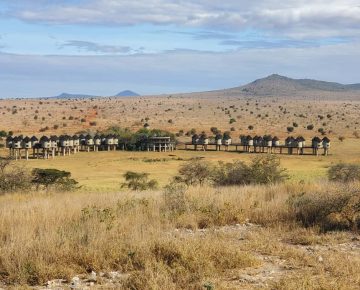Kora National Park
Located in the eastern region of Kenya, Kora National Park is a stunning expanse of wilderness that remains relatively unexplored compared to its more famous counterparts. Spanning approximately 1,787 square kilometers, this park is a sanctuary for wildlife and a paradise for nature lovers. Established in 1989, Kora National Park is known for its diverse ecosystems. These range from savannah to riverine forests, making it a critical habitat for various species.
Historical Background of Kora National Park
Kora National Park has a rich history that intertwines with Kenya’s colonial past. Originally part of a larger area designated as a game reserve, the park was officially established to protect its unique biodiversity and promote conservation efforts. It gained international attention in the 1980s when the renowned conservationist George Adamson, famous for his work with lions, was tragically murdered in the region.
Despite its historical significance, Kora remained relatively underfunded and less visited than other national parks. However, recent conservation efforts and improved accessibility have led to a renewed interest in the park as a destination for eco-tourism.

Biodiversity and Ecosystems
Flora
Kora National Park is characterized by its diverse ecosystems. They include open savannah, riverine forests, and acacia woodlands. The park’s flora is varied, with over 400 species of plants recorded, including indigenous trees such as the Acacia and the Baobab. The lush riverbanks along the Tana River provide a stark contrast to the dry savannah, supporting a range of plant life that sustains the park’s wildlife.
Fauna
The park is home to a variety of wildlife, making it a crucial area for conservation. Major animal species found in Kora National Park include elephants, lions, leopards, buffalos, and various species of antelope. The park is also known for its thriving populations of both common and rare bird species, with over 300 species recorded, including the endangered African grey parrot.
Kora’s wildlife is not only diverse but also plays a vital role in the ecological balance of the region. The presence of large herbivores like elephants helps to maintain the savannah ecosystem by controlling vegetation growth, while predators like lions and leopards contribute to the health of prey populations.
Conservation Efforts
Conservation in Kora National Park has seen significant developments in recent years. Local and international organizations have collaborated to enhance conservation initiatives, focusing on anti-poaching measures, habitat restoration, and community involvement.
Anti-Poaching Initiatives
Poaching remains a critical threat to wildlife in Kora National Park, particularly for elephants and rhinos. Conservationists have implemented various strategies to combat this issue, such as increasing ranger patrols, using technology for monitoring, and raising awareness in local communities. Collaborative efforts with law enforcement agencies have also led to successful arrests and prosecutions of poachers.
Community Engagement
Engaging local communities in conservation efforts is essential for the long-term success of Kora National Park. Through educational programs, local residents are informed about the importance of biodiversity and the benefits of conserving natural resources. Initiatives such as community wildlife conservancies have been established, allowing communities to benefit economically from eco-tourism while actively participating in wildlife protection.
Eco-Tourism Opportunities
Kora National Park is an emerging destination for eco-tourism, offering visitors a chance to explore its pristine landscapes and diverse wildlife. The park is less crowded than Kenya’s more famous national parks, providing a more intimate experience with nature.
Game Drives and Safaris
One of the most popular activities in Kora National Park is game viewing. Guided safaris provide opportunities to see a variety of wildlife in their natural habitats. The park’s varied topography allows for different viewing experiences, from open savannah plains to dense riverine forests.
Birdwatching
Birdwatching enthusiasts will find Kora to be a paradise. With over 300 species of birds, including migratory species, the park offers excellent opportunities for birding. The diverse habitats provide ideal conditions for observing both common and rare birds, making it a rewarding experience for ornithologists and casual birdwatchers alike.
Walking Safaris
For those seeking a more immersive experience, guided walking safaris are available in the park. These treks allow visitors to connect with nature on a deeper level, providing insights into the park’s ecosystems and wildlife behavior. Walking safaris led by knowledgeable guides enhance the experience, offering a unique perspective on the environment.
Challenges Facing Kora National Park
Despite its natural beauty and conservation efforts, Kora National Park faces several challenges that threaten its ecosystems.
Human-Wildlife Conflict
As human populations expand, conflicts between wildlife and local communities have become increasingly common. Livestock predation by lions and leopards can lead to retaliatory killings, undermining conservation efforts. Addressing these conflicts through community engagement and compensation programs is crucial for promoting coexistence.
Climate Change
Climate change poses significant risks to Kora National Park’s ecosystems. Changes in rainfall patterns can affect water availability, impacting both wildlife and plant life. Additionally, rising temperatures may alter habitat conditions, making it essential for conservationists to develop adaptive strategies.
The Future of Kora National Park
The future of Kora National relies on continued conservation efforts and sustainable tourism practices. By fostering community involvement and enhancing protection measures, the park can thrive as a vital ecological area.
Sustainable Tourism Development
As interest in Kora Park grows, it is essential to develop sustainable tourism practices that benefit both the environment and local communities. Eco-lodges and community-run tourism initiatives can provide economic opportunities while ensuring that the park’s natural resources are protected.
Continued Conservation Efforts
Ongoing anti-poaching initiatives, habitat restoration, and community engagement will be crucial for the park’s long-term health. Collaboration between government agencies, NGOs, and local communities can enhance conservation strategies, ensuring that Kora remains a thriving ecosystem.
Ready to explore Kora National Park?
Kora National Park is a hidden gem in Kenya’s wilderness, offering a unique blend of biodiversity, rich history, and eco-tourism opportunities. Its diverse ecosystems and wildlife make it a vital area for conservation efforts. While its lesser-known status provides an intimate experience for visitors.
As the park continues to evolve, it serves as a reminder of the importance of protecting natural resources and engaging communities in conservation. By supporting sustainable tourism and conservation initiatives, we can help ensure that Kora National Park remains a thriving sanctuary for wildlife and a beautiful destination for generations to come. Whether exploring its vast savannahs or immersing in its rich ecosystems, Kora invites all to experience its wonders and contribute to its preservation.















